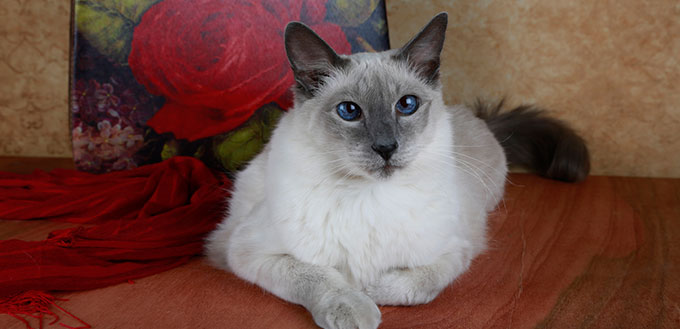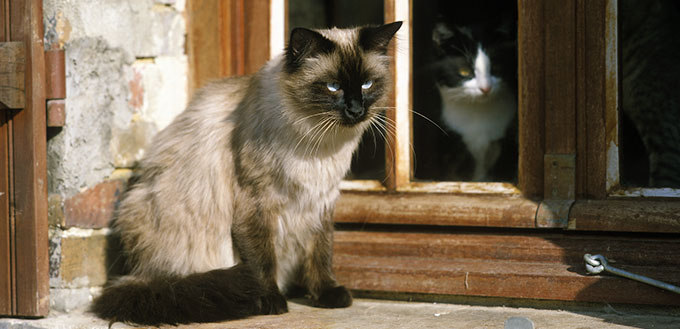Prospective cat parents would just fall in love with a Balinese cat at first sight. This cat breed is popular for their high intelligence, inquisitiveness, friendliness, playfulness, and above all, a striking beauty that puts it in a class of their own. However, Balinese cats are known to be quite demanding and very vocal, which simply adds to the fun of having one around. If you are considering adopting a Balinese as a part of your family, continue reading for more in-depth information that will explore the history of the Balinese cat, their characteristics, including health issues, grooming needs, and much more.
History of the Balinese Cat
The Balinese cat breed occurred as a result of a natural genetic mutation within the pure breed Siamese cats – this gave rise to long-haired felines. However, it was Smith who gave them the name “Balinese cat” as their graceful movement reminded her of the exotically graceful Balinese dancers.
Originally, the kitty was accepted in only four colors, brown, seal, lilac, and blue; although other colors like cream, red, tortoiseshell, were later allowed after the International Cat Association recognized the breed in 1979. Earlier in 1961, the feline was recognized by the Cat Fanciers Federation and in 1970, the Balinese cat breed earned the acceptance of the Cat Fanciers Association, as well as the American Cat Fanciers Association.
You may also like our article on: Cat Colors – Amazing Facts Behind Cat Coats & Patterns
Quick Facts About the Balinese Cat
- The Balinese is a long-coated Siamese, the difference in coat length notwithstanding; both are identical beneath the skin. They even occur in similar point colors chocolate, seal, lilac, and blue.
- Their eyes are usually medium-sized, almond-shaped, and realized as deep vivid blue.
- Both the Siamese and the Balinese are similarly built with a slender but brawny body, their heads are wedged-shaped and long, tapering from the slight point of the cat’s nose outward to its ear tips, to form a triangle.
- The ears are normally large, with a wide base and pointed tip, forming similar triangular shape with the head. Best described as tabular, the cat’s body is suspended by lengthy, slim limbs – the fore-limbs are shorter than the hind-limbs.
- Its quintessential graceful movement is achieved on little, delicate, oval paws, while it swishes a lengthy plumed tail tapered to a fine point.
- The Balinese cat personality is softened by fine, silky, mid-length fur, which is longest on the tail. The typically pointed coat has a color concentration on the face, legs, ears, and tail. What’s more, it does not have an undercoat.
- The males are larger, weighing between six to eight pounds, while the females come way lower with a bodyweight ranging from five to seven pounds.
- Their life span ranges from 15 to 20 years.
- There is a general claim that the breed causes lesser problems of allergies compared to other felines.
- While we still await scientific evidence for the claim, the Balinese cats have been proved to produce a lesser amount of Fel d4 and Fel d1 protein allergens compared to other breeds.
Things You Should Know
Health
The anticipated health problems with the Balinese Cats are not much as the feline is believed to be a generally healthy breed. However, they are prone to the same ailments that affect the Siamese felines. We have seen the likes of respiratory issues like chronic bronchial disease, kinked tail, crossed eye, eye problems like retinal atrophy and glaucoma, bladder stones, periodontal disease, and cancer.
Feeding
Feeding for the Balinese cat should come in a high-quality diet rich in animal protein and properly portion-controlled—this aids in preventing weight-related health issues. Also, this cat breed is quite picky when it comes to food; thus, wet food will be preferable to dry cat food. Remember, a cat on a wet diet will naturally require a more frequent dental hygiene routine to prevent tooth and gum disease.
Related Post: Wet Cat Food
Care
Cats are so particular about their bathroom hygiene; thus, their litter boxes ought to be spotlessly clean at all times. Train them to do their business within the litter box, and once it is soiled, the litter must be changed. Keeping your feline friend as an indoor-only cat is your best option – this way, it will be safe from the spread of contagious disease, from road mishaps, and attacks by dogs, or even wild animals like coyotes.
Cats that are allowed to move outside stand the risk of being hit by oncoming vehicles, hence the need to keeps yours indoors. Even in the absence of accidents, we should factor the incidences of cat theft, which can happen at any time.
Caring for these cat breeds can stretch their budget. No doubt, many of us would love to own the beautiful Balinese cat without parting with the substantial amount of money required to take care of them; however, this is all part of the package.
Grooming
Grooming needs for the Balinese cat is medium. As they are not born with an undercoat, the possibility of tangling and matting is very low. What’s more, shedding is also low; nevertheless, the cat needs to be brushed several times weekly to distribute the skin oil, prevent mats, get rid of dead hair, and keep the coat in tip-top shape. No doubt, brushing time is bonding time between cat and adopter, so it pays to take advantage.
Related Post: Brush For Cats
Other grooming needs of the Balinese include monthly nail trimming, the ears and eyes should be cleaned as the need arises, and since the cat is prone to periodontal disease, the teeth should be brushed daily or weekly as the case may be.
Related Posts: Cat Toothpaste and Cat Toothbrush
Temperament
The character trait of the Balinese is just the same with the Siamese. Balinese kittens are excessively playful, a trait which they carry into adulthood. Consequently, they end up as notably social adults with heightened interest in the goings-on in their vicinity. The cat also has a persistent nature and tends to vocalize, albeit at a reduced volume.
And among the long-haired felines, the Balinese is reputed to be the most intelligent. The kitty is also known to be very acrobatic and loves to spend intimate time with its human family. It goes without saying that the feline is highly active.







